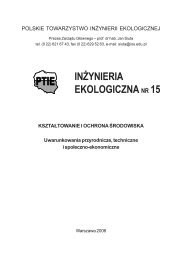Inżynieria Ekologiczna Nr 2
Inżynieria Ekologiczna Nr 2
Inżynieria Ekologiczna Nr 2
You also want an ePaper? Increase the reach of your titles
YUMPU automatically turns print PDFs into web optimized ePapers that Google loves.
TECHNOLOGIE ODOLEJANIA GRUNTÓW, ODPADÓW, ŒCIEKÓW<br />
the soil or water column. Bacteria can be injected directly into ‘hot spots’ of contamination<br />
within the soil, sprayed onto the surface of a slick within a contaminated water body or<br />
in some cases the oil or petrol etc. can be abstracted in aqueous phase and treated in a<br />
purpose built bio-reactor commissioned on-site.<br />
Benefits or Direct Application verses ‘Pump and Treat’ Techniques<br />
There are several trains of thought with respect to the most effective application technique<br />
for bio-remediation technology. To a large extent the most efficient technique is<br />
highly site and pollutant specific.<br />
In the past, the bio-remediation of shore lines and soil adversely affected by major oil<br />
spill has been achieved through the stimulation of the indigenous population of microorganisms.<br />
Products have been developed which biologically invigorate the inherent bacterial<br />
population at a particular site to such an extent that that the oil or pollutant is more<br />
rapidly broken down. In this case the only addition required is a ‘Nutrient’ which can be<br />
both cheap and effective in certain instances.<br />
At the next level of bio-remedial sophistication, it is possible to apply large volumes<br />
of the precise bacteria known to be able to survive in the environment in question and to<br />
effectively degrade the pollutant causing the problem. There is knowledge on the bio-degradation<br />
capabilities of each species of bacteria which has been isolated from polluted<br />
sites. Moreover, many species can be cheaply cultured on an industrial scale. As such, it is<br />
usually preferable to physically add a cocktail of bacteria by spraying onto the soil or water<br />
surface of by direct injection.<br />
With the current level of sophistication in industrial bio-technology, bacteria can by<br />
cultured to in excess of 10´12 individual bacteria per millilitre of product. With this degree<br />
of bio-enhancement, bacteria can be added to a site in such high numbers that there is<br />
no real requirement for a natural population to be present. Again a biological activator<br />
product is add along with the bacteria to stimulate biological activity and to promote longevity<br />
of the population.<br />
Direct applications of bacteria and activator in this way require a more detailed knowledge<br />
of the site conditions and the type of pollution which will be encountered. When<br />
applying a bacterial culture directly to a contaminated site, whether it be on the surface of<br />
a water body or deep in the soil under a building, of example, the application will usually<br />
take the form of a cocktail of between six and ten different species. Using a mixture allows<br />
for each species to be highly specific in its usefulness and it its tolerance of environmental<br />
conditions while the complete application can solve a complex pollution problem under a<br />
variety of environmental conditions.<br />
Where it feasible to commission a bio-reactor on-site, the treatment process can be<br />
massively accelerated since the level of control over the environment in which the bacteria<br />
are expected to thrive is increased. A bio-reactor usually takes the form of a glass-fibre<br />
reinforced plastic tank some 3 metres in diameter and standing 3 metres high. The units<br />
therefore have a capacity of 6.000 litres. Polluted water can be passed through at a rate of<br />
up to 1.000 litres per hour. Units of this size can be easily transported to any location. As<br />
167



